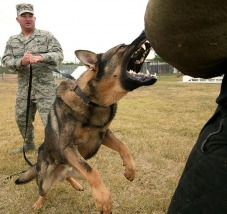ATTACK DOG TRAINING

Dogs are known to be the guardians of their keepers. They are usually very protective and they can be very aggressive towards strangers and those who threaten their keepers or trainers. That is why many people acquire dogs for the purpose of just having someone to trust and rely on for protection. Many people purchase dogs due to a goal of having an unhesitating attacker against possible threats. However, there are times when dogs may attack people not just because of a possible threat. There are moments when dogs attack just out of fear or anger. This is when attack dog training should be done.
Attack dog training is the process of training a dog to control when to attack. This type of dog training allows the professional trainers and dog owners to teach their pet how to respond to certain types of situations when danger is at hand. Usually, the training is focused on honing the dog’s obedience to his master or trainer. This allows the master or trainer to tell the dog when to act and attack and when to stop from doing so. Attack dog training also teaches the dog about certain situations when a command to attack is no longer necessary and instead, the attack should be done immediately-without hesitation- because the master, trainer or the dog itself is clearly in danger.
Also, attack dog training teaches the pup about the mechanics of fighting and protecting. It orients the dog about the many different defense actions and offensive procedures such as barking, biting, pouncing, and many more, along with its effects on the target.
If you are not a professional dog trainer, then, you should not attempt to provide the attack dog training by yourself. The process of teaching dogs when to attack varies, depending on the dog’s capabilities. Regardless of the chosen teaching process however, this type of training is not just any regular training that requires just perseverance. Rather, attack dog training needs extra firmness, strength, and commitment for the dog, but especially for the trainer.
The process of dog training should be taken one step at a time, with clear intervals and timing. The course usually starts with the basic lessons of obedience. After the obedience training, the trainer should then proceed with training the dog to socialize with other people and pets. The dog should learn to interact with others not through aggression, and they should learn to follow their trainers/keepers even when distractions are present.
Afterwards, the dog should be familiarized with the concept of an “agitator”. The dog should be able to identify an agitator as someone who is a possible threat to the dog and the keeper/trainer. Familiarizing the dog with the idea that the agitator is a stimulator for aggressive action allows the dog to retract and respond to dangerous or threatening situations. Then, whenever the dog responds to the stimulant, the trainer should prompt the dog to chase and fully attack the agitator. The usual attack that is expected is a bite in the arm. If the chase and the attack are successful, the dog should be given rewards and praise. Punishment training should not be an option for attack dog training because such can confuse the dog regarding the concepts of threat and agitator.
